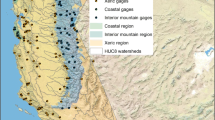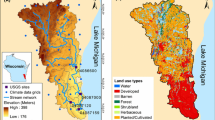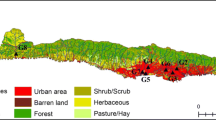Abstract
Projections of a drier, warmer climate in the U.S. Southwest would complicate management of the Colorado River system—yet these projections, often based on coarse resolution global climate models, are quite uncertain. We present an approach to understanding future Colorado River discharge based on land surface characterizations that map the Colorado River basin’s hydrologic sensitivities (e.g., changes in streamflow magnitude) to annual and seasonal temperature and precipitation changes. The approach uses a process-based macroscale land surface model (LSM; in this case, the Variable Infiltration Capacity hydrologic model, although methods are applicable to any LSM) to develop sensitivity maps (equivalent to a simple empirical model), and uses these maps to evaluate long-term annual streamflow responses to future precipitation and temperature change. We show that global climate model projections combined with estimates of hydrologic sensitivities, estimated for different seasons and at different change increments, can provide a basis for approximating cumulative distribution functions of streamflow changes similar to more common, computationally intensive full-simulation approaches that force the hydrologic model with downscaled future climate scenarios. For purposes of assessing risk, we argue that the sensitivity-based approach produces viable first-order estimates that can be easily applied to newly released climate information to assess underlying drivers of change and bound, at least approximately, the range of future streamflow uncertainties for water resource planners.




Similar content being viewed by others
References
Abatzoglou JT, Brown TJ (2012) A comparison of statistical downscaling methods suited for wildfire applications. Int J Climatol 32:772–780. doi:10.1002/joc.2312
Barnett TP, Pierce DW (2008) When will Lake Mead go dry? Water Resour Res 44, W03201. doi:10.1029/2007WR006704
Barnett T, Malone R, Pennell W, Stammer D, Semtner B, Washington W (2004) The effects of climate change on water resources in the West: introduction and overview. Clim Chang 62(1):1–11
Bates BC, Kundzewicz ZW, Wu S, Palutik JP (eds) (2008): Climate change and water. technical paper of the intergovernmental panel on climate change, IPCC Secretariat, Geneva, 210 pp
Brekke LD, Kiang JE, Olsen JR, Pulwart RS, Raff DA, Turnipseed DP, Webb RS, White KD (2009) Climate change and water resources management—A federal perspective: U.S. Geological Survey Circular 1331, 65 p. Available online at: http://pubs.usgs.gov/circ/1331
Christensen NS, Lettenmaier DP (2007) A multimodel ensemble approach to assessment of climate change impacts on the hydrology and water resources of the Colorado River basin. Hydrol Earth Syst Sci 3:1–44
Christensen NS, Wood AW, Voisin N, Lettenmaier DP, Palmer RN (2004) The effects of climate change on the hydrology and water resources of the Colorado River Basin. Clim Chang 62:337–363
Das T, Pierce DW, Cayan DR, Vano JA, Lettenmaier DP (2011) The Importance of warm season warming to western U.S. streamflow changes. Geophys Res Lett 38:L23403. doi:10.1029/2011GL049660
Dooge JCI (1992) Sensitivity of runoff to climate change: a Hortonian approach. Bull Am Meteorol Soc 73:2013–2024
Dooge JC, Bruen M, Parmentier B (1999) A simple model for estimating the sensitivity of runoff to long-termchanges in precipitation without a change in vegetation. Adv Water Resour 23:153–163. doi:10.1016/S0309-1708(99)00019-6
Elsner MM, Cuo L, Voisin N, Deems JS, Hamlet AF, Vano JA, Mickelson KEB, Lee SY, Lettenmaier DP (2010) Implications of 21st century climate change for the hydrology of Washington State. Clim Chang 102(1):225–260
Fulp T (2005) How low can it go. Southwest Hydrol 4(2):16–17
Hamlet AF, Salathé EP, Carrasco, P (2010) Statistical downscaling techniques for global climate model simulations of temperature and precipitation with application to water resources planning studies. Final Rep. for the Columbia Basin Climate Change Scenarios Project, 27 pp. [Available online at www.hydro.washington.edu/2860/products/sites/r7climate/study_report/CBCCSP_chap4_gcm_final.pdf.]
Harding BL, Wood AW, Prairie JR (2012) The implications of climate change scenario selection for future streamflow projection in the Upper Colorado River Basin. Hydrol Earth Syst Sci Discuss 9:847–894. doi:10.5194/hessd-9-847-2012
Intergovernmental Panel on Climate Change (IPCC) (2007) In: Solomon S, Qin D, Manning M, Chen Z, Marquis M, Averyt KB, Tignor M, Miller HL (eds) Climate change 2007: The physical science basis. contribution of working group I to the fourth assessment report of the IPCC. Cambridge University Press, Cambridge, http://www.ipcc.ch/ipccreports/ar4-wg1.htm
Liang X, Lettenmaier DP, Wood EF, Burges SJ (1994) A simple hydrologically based model of land surface water and energy fluxes for general circulation models. J Geophys Res 99:14 415–14 428
Maurer EP, Wood AW, Adam JC, Lettenmaier DP, Nijssen B (2002) A long-term hydrologically-based data set of land surface fluxes and states for the conterminous United States. J Clim 15:3237–3251
Nijssen B, Schnur R, Lettenmaier DP (2001) Global retrospective estimation of soil moisture using the variable infiltration capacity land surface model, 1980–1993. J Clim 14:1790–1808
Payne JT, Wood AW, Hamlet AF, Palmer RN, Lettenmaier DP (2004) Mitigating the effects of climate change on the water resources of the Columbia River basin. Clim Chang 62:233–256
Sankarasubramanian A, Vogel RM, Limbrunner JF (2001) Climate elasticity of streamflow in the United States. Water Resour Res 37:1771–1781
Schaake J C (1990) From climate to flow. Climate change and U.S. water resources, P. E. Waggoner (ed) John Wiley, 177–206
USBR (United States Bureau of Reclamation) (2011) Colorado River Basin Water Supply and Demand Study, Interim Report No. 1. U.S. Department of the Interior, Boulder City, Nevada. http://www.usbr.gov/lc/region/programs/crbstudy.html, accessed October 18, 2011
USBR (United States Bureau of Reclamation) cited (2012) CURRENT natural flow data 1906–2008, last updated January 16, 2011. [Available online at http://www.usbr.gov/lc/region/g4000/NaturalFlow/current.html]
Vano JA, Das T, Lettenmaier DP (2012) Hydrologic sensitivities of Colorado River runoff to changes in precipitation and temperature. J Hydrometeorol 13:932–949. doi:10.1175/JHM-D-11-069.1
Vano JA, Udall B, Cayan DR, Overpeck JT, Brekke LD, Das T, Hartmann HC, Hidalgo HG, Hoerling M, McCabe GJ, Morino K, Webb RS, Werner K, Lettenmaier DP (2013) Understanding uncertainties in future Colorado River Streamflow. Bull Amer Meteor Soc. doi:10.1175/BAMS-D-12-00228.1
Western Water Assessment (WWA), Colorado climate change: a synthesis to support water resource management and adaptation. Oct 2008 (available online at: http://cwcb.state.co.us/public-information/publications/Documents/ReportsStudies/ClimateChangeReportFull.pdf)
Wood AW, Lettenmaier DP (2006) A test bed for new seasonal hydrologic forecasting approaches in the western United States. Bull Am Meteorol Soc 87:1699–1712
Wood AW, Leung LR, Sridhar V, Lettenmaier DP (2004) Hydrologic implications ofdynamical and statistical approaches to downscaling climate model outputs. Clim Chang 62(1–3):189–216
Woodhouse CA, Gray ST, Meko DM (2006) Updated streamflow reconstructions for the upper Colorado River Basin. Water Resour Res 42, W05415. doi:10.1029/2005WR004455
Acknowledgments
The authors thank James Prairie (USBR) for his assistance in accessing USBR Colorado River Basin Water Supply and Demand Study data, Bart Nijssen (University of Washington) for his feedback on the sensitivity-based approach development, and three anonymous reviewers for their constructive comments on the manuscript. Support for this work was provided by NOAA’s Regional Integrated Science Assessment program, grant number NA10OAR4310218, to Oregon State University’s Climate Impacts Research Consortium.
Author information
Authors and Affiliations
Corresponding author
Electronic supplementary material
Below is the link to the electronic supplementary material.
ESM 1
(PDF 721 kb)
Rights and permissions
About this article
Cite this article
Vano, J.A., Lettenmaier, D.P. A sensitivity-based approach to evaluating future changes in Colorado River discharge. Climatic Change 122, 621–634 (2014). https://doi.org/10.1007/s10584-013-1023-x
Received:
Accepted:
Published:
Issue Date:
DOI: https://doi.org/10.1007/s10584-013-1023-x




